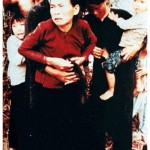
The Vietnam War produced many indiscriminate killings, civilian casualties and war crimes. Perhaps the best known is the killing of Vietnamese villagers by American soldiers at My Lai. In March 1968 soldiers from ‘Charlie’ Company, deployed in the coastal province of Quang Ngai, were sent into areas believed to house Viet Cong soldiers and sympathisers. Operating under stress and with questionable intelligence and unclear orders, the soldiers entered the small hamlet of My Lai and began firing indiscriminately on people and buildings. When they left at dusk, hundreds of Vietnamese peasants lay dead, the vast majority of them women, children and the elderly. The incident was concealed for several months, until revealed by concerned American soldiers and, later, journalist Seymour Hersh. The My Lai massacre, as it became known, caused horror and outrage in the United States and around the world. It raised questions about the methods being used in Vietnam and whether American soldiers were doing more harm than good.
Company C of 1st Battalion 20th Infantry Regiment had arrived in Vietnam at the end of 1967. By March the following year, it was already under considerable strain. In its first three months Charlie Company (as it was more generally known) had been involved in patrols rather than major combat operations, yet it had lost more than a dozen men – five killed, the rest severely wounded – to Viet Cong mines and booby traps. In command of Charlie Company was Captain Ernest Medina, a career soldier who joined the army as a cook but worked his way up to officer rank. Charlie Company contained around 110 men spread across three platoons. Its 1st Platoon was led by Second Lieutenant William Calley, a high school drop out from California who had joined the army in mid-1966. According to both his superiors and subordinates, Calley was unpopular and barely competent – and at times not even that. According to some under his command, Calley’s incompetence had led to discussions about his possible ‘fragging’ (assassination by an intentionally misplaced grenade).
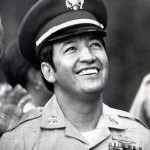
In March 1968 Charlie Company, along with two other companies, received orders to investigate a number of villages in Quang Ngai, about 180 kilometres south of Hue. There had been Viet Cong activity in the area and intelligence suggested local villages were supplying Viet Cong guerrillas and possibly giving them haven. Company commanders were ordered to engage with the enemy and destroy wells, livestock and food stores being used to supply the Viet Cong. When Medina relayed these orders to the men of Charlie Company, he did so ambiguously, causing considerable confusion about the mission’s exact objectives. According to one report, when soldiers asked who the enemy actually was, Medina stated: “Anybody running from us”. Medina also allegedly told his men that by early morning villagers not aligned with the Viet Cong would be at market; those remaining in the village were likely to be communist sympathisers.
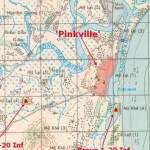
On March 16th a total of 80 soldiers from Charlie Company entered My Lai. It was spearheaded by Lieutenant Calley and his 1st Platoon. Calley’s men began firing at buildings and locations they believed were sheltering Viet Cong. No armed personnel were found, in fact it soon became apparent that the village was entirely occupied by women, children and elderly men. This discovery did not stop the shooting, which began to escalate into a frenzy. Calley and his men rounded up a group of 80 civilians and machine-gunned them in the village square. Villagers found hiding in buildings and bunkers were also murdered, either with gunfire or hand grenades. Livestock and pets were also shot or bayoneted. Unconfirmed reports claimed that soldiers raped women and young girls. According to testimony later provided by a survivor:
“They ordered all the families to come out and told us to march towards a ditch. We came to an assembly point and huddled together. They shot us one by one. I saw a little boat and used it to cover my son, and dead bodies fell down on me. I kept telling my son: ‘Please do not cry, they will hear us if you do’. When the Americans had finished, they walked away. I waited then stood up with my son. I felt I was walking in the sky; I was without feeling and was covered with blood. On the way back we walked through the fields because the pathways were littered with bodies.”
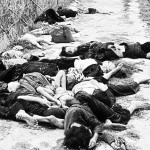
By mid-morning, Charlie Company’s 2nd and 3rd Platoons had entered the fray, sweeping through outlying villages and killing every human being and animal they could find. Three groups of villagers were ordered into large ditches then sprayed with machine gun fire. Both Medina and Calley participated in these killings. According to one eyewitness, when a small boy emerged from one of the ditches and fled across a field, Calley chased him and gunned him down. By noon, most civilians in My Lai and its surrounding hamlets had been exterminated. The men of 1st Platoon then paused for lunch, some sitting to eat beside a ditch filled with corpses. After this, they resumed the search for villagers hiding in vegetation or bunkers. As per their orders, they burned food supplies and destroyed or poisoned wells. By dusk, the operation had concluded and the men of Charlie Company returned to their base. Reports of the death toll in the My Lai vary. American reports suggest that 347 people were killed; Vietnamese government reports put the dead at 504, 56 of them less than one year old.
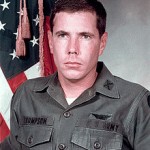
The frenzied slaughter at My Lai had proceeded without challenge. Later investigations found that some individual soldiers from Charlie Company refused to participate in the killing of civilians. Some even challenged the orders given by superior officers. A US helicopter crew, tasked with monitoring the operation from above, actively intervened to save the lives of several villagers. On one occasion an American helicopter pilot, Hugh Thompson, spotted a small group of civilians cowering in a ditch as soldiers approached, apparently to shoot them. Thompson gave his crew orders to attack the advancing soldiers if they opened fire on the villagers. His chopper rescued these and other civilians, many of them wounded, and airlifted them to safety. Hugh Thompson was later twice decorated for bravery for his actions at My Lai. He later served as an important witness in the prosecution case against Calley.
1st Battalion’s official report into the My Lai operation portrayed it as a heated gun battle between the Americans and Viet Cong insurgents. According to this report, 128 Viet Cong had been eliminated and 22 civilians were killed in the crossfire. The men of Charlie Company were congratulated for the My Lai operation, which was hailed as a success, both by American generals and in the press. This cover-up did not last long. Two young American servicemen, Tom Glen and Ronald Ridenhour, were not present at My Lai but heard of the atrocities there through word of mouth. Acting independently of each other, Glen and Ridenhour wrote letters calling for an investigation into the events of March 16th. Glen’s correspondence to General Creighton Abrams led to an internal US Army investigation. Its report, completed in December 1968, rubbished Glen’s claims. It found that he was not directly involved in the operation and therefore had no accurate knowledge of what happened there.
Ridenhour, however, pushed the case further. Though not present at My Lai, Ridenhour was a member of Charlie Company, so he was in constant communication with the soldiers who were. Ridenhour spoke informally to as many men as he could, later making copious notes. He later said of this process:
“I’d ask them, “Hey, man what happened at Pinkville? [My Lai]” And it would be like lancing a boil. I mean, if you asked them, they were compelled to talk. They couldn’t stop talking. They were horrified that it had occurred, that they had been there, and in the instances of all of these men, that they had participated in some way. [I asked my friend Mike Terry] “Hey, Mike, what happened at Pinkville? Tell me what happened at Pinkville.” And he tells me this terrible story of going in with Lieutenant Calley, and sweeping through the village and watching these murders and the rapes and everything that was going on and seeing what was happening, what happened at the ditch. About eleven o’clock Mike and Billy sat down within fifteen or twenty feet of the ditch to have their lunch. They took out their C-rations and opened their food and started eating but they couldn’t really finish it, because there was too much noise coming from the ditch. People who are mortally wounded but not yet dead make a lot of noise. People die hard; they don’t want to give up life. The people in this ditch were laying there. Those who were still alive were groaning and crying out and some of their limbs were flopping spasmodically, which happens to people who are mortally wounded.”
“Last train to Nuremberg!
Last train to Nuremberg!
Last train to Nuremberg!
All on board!
Do I see Lieutenant Calley?
Do I see Captain Medina?
Do I see General Koster and his crew?
Do I see President Nixon?
Do I see both houses of Congress?
Do I see the voters, me and you?”
Pete Seeger, songwriter
After completing his tour of duty in Vietnam, Ridenhour returned to the US and began writing letters to officials, calling for further investigation into the events at My Lai. Unlike Tom Glen, Ridenhour went further than just army commanders. He wrote to the Pentagon, the White House, the State Department and numerous members of Congress. Most ignored him, however, the US Army came under pressure to conduct a more thorough investigation, which it did through the middle of 1969. Dozens of servicemen were interviewed by chief investigator Colonel William Wilson. He did not take long to expose the horrors that occurred at My Lai. “I had prayed to God that this thing was fiction,” Wilson said, “but I knew now that it was fact”. Investigators flew to My Lai, interviewed survivors and exhumed graves. They reconstructed Charlie Company’s operation, minute by minute, to identify exactly who was responsible for particular killings. By September 1969 Wilson’s team had gathered enough evidence to charge Lieutenant Calley with murder. Another 25 soldiers, including Captain Medina, were later charged with other offences. An additional 14 military personnel were later charged with concealing information about the events at My Lai.
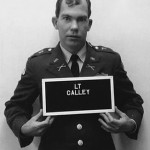
The American public did not learn of the My Lai massacre until November 1969, a full 18 months after it had occurred. The story was broken by investigative journalist Seymour Hersh, who was later awarded a Pulitzer Prize. The My Lai affair was a disaster for the Nixon administration, which was already under fire from the press and the anti-war movement. Calley went to trial in November 1970, charged with giving orders that led to the murder of 109 Vietnamese civilians. Calley’s initial defence – that the dead villagers were accidentally shot by helicopter gunfire – was rapidly quashed. He then claimed to have followed the somewhat ambiguous orders of his superior officer, Captain Medina. In March 1971 Calley was found guilty and sentenced to life imprisonment. He remains the only American convicted in relation to the atrocities at My Lai. A raft of legal appeals reduced Calley’s sentence to 20 years, then to 10, before a presidential pardon in October 1974 set him free. Altogether he had served less than four years, for what was arguably the worst war crime of the Vietnam War. Few historians believe that Calley was solely or even mostly responsible for the events at My Lai.
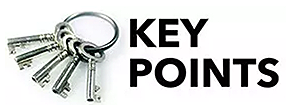
1. The My Lai massacre refers to the killing of between 347 and 504 Vietnamese civilians by US soldiers in March 1968. This took place during clearing operations in Quang Ngai province.
2. These operations were carried out by ‘Charlie’ Company, 1st Battalion 20th Infantry Regiment, under the command of Captain Ernest Medina. Leading the incursion was 1st Platoon, led by Lieutenant William Calley.
3. After entering My Lai and its surrounding hamlets, the soldiers of ‘Charlie’ Company found no obvious Viet Cong. Instead, they opened fire on civilians, killing between 347 and 504, mostly women, children and the elderly.
4. The operation in Quang Ngai was reported as successful and the killings were concealed for several months. Talk of the incident, however, prompted two soldiers to lobby commanders and officials for an investigation.
5. A thorough investigation in 1969 uncovered a weight of evidence and led to charges being laid against Lieutenant Calley. He was sentenced to life imprisonment for the My Lai massacre but served less than four years.

Ron Ridenhour’s letter to the US Congress exposing My Lai (March 1969)
Quotations about the massacre at My Lai hamlet (1968)
Seymour Hersh breaks the story of the My Lai killings (1969)
PFC Paul Meadlo recalls his role in the killings at My Lai (November 1969)
Cross examination of Lieutenant William Calley (1970)
Cross examination of Captain Ernest Medina (1970)
© Alpha History 2018. Content on this page may not be republished or distributed without permission. For more information please refer to our Terms of Use.
This page was written by Jennifer Llewellyn, Jim Southey and Steve Thompson. To reference this page, use the following citation:
J. Llewellyn et al, “The My Lai massacre”, Alpha History, accessed [today’s date], https://alphahistory.com/vietnamwar/my-lai-massacre/.
